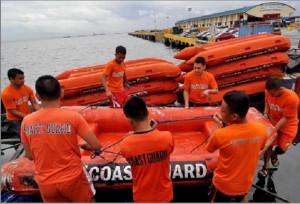Rescuers race to help typhoon-hit towns

Members of the Philippine Coast Guard prepare the fiber glass boat for Typhoon Labuyo at Pier 13 of Manila South Harbor in Manila. PHOTO BY RICHARD A. REYES
MANILA, Philippines — Rescuers used helicopters and bulldozers on Tuesday to reach isolated towns devastated by deadly Typhoon Labuyo (international codename: Utor), which left tens of thousands homeless and a trail of destruction in its wake.
The government reported that two people had been confirmed killed and 11 others were missing after Labuyo, the strongest storm this year, swept across the north of the country on Monday.
“Trees have fallen down, roofs have been torn off houses, electric poles and electric towers have collapsed,” National Disaster Risk Reduction and Management Council spokesman Reynaldo Balido said, describing chaos from coastal towns to mountain villages hundreds of kilometers apart.
The Philippines is one of the world’s most vulnerable countries to typhoons, as it is where storms often make their first landfall after they emerge out of the Pacific Ocean and move west.
Hundreds of people die from the roughly 20 typhoons or tropical storms that strike the Philippines each year.
Article continues after this advertisementLabuyo hit land with wind gusts reaching 200 kilometers an hour early Monday, making it the strongest storm this year, according to the weather bureau.
Article continues after this advertisementHowever there were hopeful signs that the Philippines had escaped Labuyo with a relatively small number of casualties, after soldiers and other rescue workers reached three towns on Tuesday that were believed to be the worst hit.
The towns, home to about 45,000 people in Aurora province on the east coast of the main island of Luzon, were in Labuyo’s direct path when it made landfall before dawn on Monday.
Soldiers who clambered over landslide-choked roads to reach the areas on foot said they saw substantial damage to homes and other buildings, but residents reported no major casualties, according to northern Philippines military spokesman Major Ernesto Garcia.
“Military troops are already in the said area conducting rescue and clearing of roads and distributing relief goods,” he told AFP.
Three military helicopters also flew to the area in the afternoon, bringing aid and experts to assess longer-term needs, said the Aurora provincial disaster official, Elson Egargue.
Joe Curry, country chief of the aid group Catholic Relief Services, said it expected the major road to the isolated towns to reopen by Wednesday.
He said other people involved in the rescue and relief operation said the death toll may be lower than feared because residents were well prepared.
“I think people are agreeing that these places have been hit many times before, so they know how to deal with typhoons. The flood damage is less than it has been before,” Curry said.
Philippine National Red Cross secretary-general Gwendolyn Pang also told AFP that people in the worst-hit areas were typhoon veterans.
“They know how to prepare, they know how to check for early warning signs like flood levels,” she said.
Nevertheless, more than 30,000 people were in temporary shelters on Tuesday after Labuyo destroyed more than 2,000 homes, according to the national government’s disaster management council.
The two confirmed fatalities were a man who drowned and another who was buried by a landslide.
Of the 11 people listed as missing, one was a woman filmed by a television crew as she stood crying for help atop her house that was swept away by a swollen river.
“The community was evacuated before the onslaught of the typhoon but she refused to be evacuated,” said Norma Talosig, civil defense chief for the area.
The Red Cross listed a third death but gave no details.
Talosig said the typhoon had also caused severe damage to farms in the province of Isabela, one of the country’s top rice and corn producers.
On Tuesday afternoon, Labuyo was in the South China Sea tracking towards southern China, according to the Hong Kong Observatory.
It said Labuyo’s wind gusts were reaching 175 kilometers an hour.
Related stories:
Labuyo damages P57M properties in Luzon